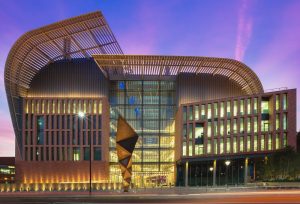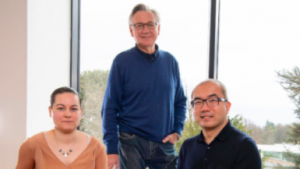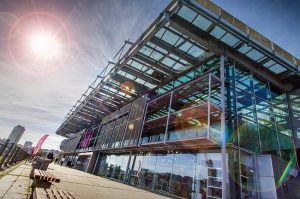Changing Lives; why philanthropy is vital in giving young people a chance.
‘Changing Lives’ was written for Beacon Collaborative by Daniel Flynn, CEO of YMCA North Staffordshire. Find out more about Daniel below.
Opportunities for young people to change their path in life are not easy to come by, particularly for those without the networks and support to effect change.
There is often an assumption that young people know what they want and have the capacity to make the correct decisions for themselves. But young people do not know what they do not know. How can we expect them to achieve a better life without the relationships and people to help them?
For those young people with parents that have high social capital, they have one key thing – access. Access to opportunities, travel and vast networks which allow them to make positive choices based on their extensive experiences. Access to try things out, have a go and take that first step. These opportunities are simply not available to their poorer and less connected counterparts.
Many interventions have attempted to address the issue of social mobility but have not quite succeeded. But where broad initiatives have failed, philanthropy has often succeeded. Philanthropists have the flexibility to apply their funding in a variety of ways, based on what the situation demands. For this reason, philanthropic money can play a pivotal role in changing the life chances of young people. Here are a few tips for how to use your money to promote social mobility and change the lives of young people…
1. Creating the capacity to engage and learn.
For so many young people our educational system does not work. We need to think about how we create the space to learn in different ways – through art, sport, nature and more. The capacity to learn is a gift young people will take with them throughout their life. Let’s make sure they are engaged and understand the value of learning and education.
-
-
- What you can do: Funding Arts initiatives, nature groups and sports schemes are great ways to build the confidence of typically disadvantaged young people and engage them in learning.
-
2. Promoting Travel
Travel changes lives. Culture enriches our soul. The more we learn about our world, the more fulfilled our lives can be. Many young people are trapped by poverty, but poverty is not limited to financial opportunity. It is also the poverty of never seeing the countryside, never experiencing another culture. Travel promotes equality and inclusion and can often be a turning point in a young person’s life, providing different perspectives and stimulating exploration.
-
-
- What you can do: Fund a national/international residential. Offer opportunities to visit/meet extraordinary people and places through networks. Sponsor a young person on an oversees placement.
-
3. Building Networks
Children of middle-class parents have access to a vast array of people who can help them on their way. Want to be a doctor, lawyer, business owner? Those parents will know someone who can help and will rightly use these networks to help their children. What about children who have no parents – or are carers/care leavers? How do we use our networks for them too? Relationships change people’s lives. How do we increase young people’s social capital to improve their life chances?
-
-
- What you can do: Offer work placements/work experience. Host events which young people can attend to meet new people. Offer coaching/mentoring. Connect with schools and charities, meeting young people directly to hear their stories and share yours. Open up your business to do a show and tell. Expose young people to your networks and your worlds.
-
4. Providing Resources
A huge barrier to anyone’s next step in life – particularly a young person’s – is having the resources to follow their passions. Bursaries can provide a huge cushion for young people and can be used in multiple ways to help them progress. This can mean many things, from driving lessons to a laptop, to furnishing their student accommodation. Not having the resources to take your next step is so limiting. Let’s work to change that.
-
-
- What you can do: Provide bursary funding to young people. Make it largely unrestricted so they have access to funds which cover a large area of their need.
-
A young person’s future should not be determined by their past. With the right love, support, opportunities and people, every life can be positively changed.
To quote Rupi Kaur…
“We are all born / so beautiful / the greatest tragedy is / being convinced we are not .”
Daniel Flynn is CEO of YMCA North Staffordshire, he has worked in the charitable sector for the last 35 years. His work has focused around social housing and homelessness, and he clearly understands the linkages between design and outcome. YMCA is still the biggest youth based charity in the world based in 138 countries servicing 50 million people every day, He works nationally and internationally for YMCA, working in West Africa and Israel/Palestine. He is committed to the area and loves to see the green shoots of creativity that he believes will unlock the prosperity of all.




 From an economic standpoint, we need a society that puts arts and culture at the heart of its towns and cities. There is nothing ‘nice to have’ about the arts and the creative industries. Arts and Culture are central to our economy, our public life and our nation’s health. Cultural and creative industries are typically labour-intensive, employing people in the community and creating jobs that cannot be done anywhere else. They increase footfall and spending not only in the cultural activity itself but also around it. With the decline of high street retail as the main driver of towns and cities it is more important than ever to encourage, develop and fund cultural venues and cultural activities in our towns and cities.
From an economic standpoint, we need a society that puts arts and culture at the heart of its towns and cities. There is nothing ‘nice to have’ about the arts and the creative industries. Arts and Culture are central to our economy, our public life and our nation’s health. Cultural and creative industries are typically labour-intensive, employing people in the community and creating jobs that cannot be done anywhere else. They increase footfall and spending not only in the cultural activity itself but also around it. With the decline of high street retail as the main driver of towns and cities it is more important than ever to encourage, develop and fund cultural venues and cultural activities in our towns and cities.
 NewcastleGateshead Quayside is a good example of the successful pursuit of regeneration through active intervention. Prior to the Quayside redevelopment, the area was severely depressed, lacking attractions for visitors and suffering economically as a result. The Baltic Flour Mills, now repurposed as
NewcastleGateshead Quayside is a good example of the successful pursuit of regeneration through active intervention. Prior to the Quayside redevelopment, the area was severely depressed, lacking attractions for visitors and suffering economically as a result. The Baltic Flour Mills, now repurposed as  The growth of Nissan and out-of-town call centres did much to reduce mass unemployment but did little for a city centre blighted by low footfall, a poor retail offer (competing with out of town shopping malls) and limited cultural attractions. By 2010 about one-third of the city’s retail properties were empty and the
The growth of Nissan and out-of-town call centres did much to reduce mass unemployment but did little for a city centre blighted by low footfall, a poor retail offer (competing with out of town shopping malls) and limited cultural attractions. By 2010 about one-third of the city’s retail properties were empty and the  For many years, the
For many years, the 